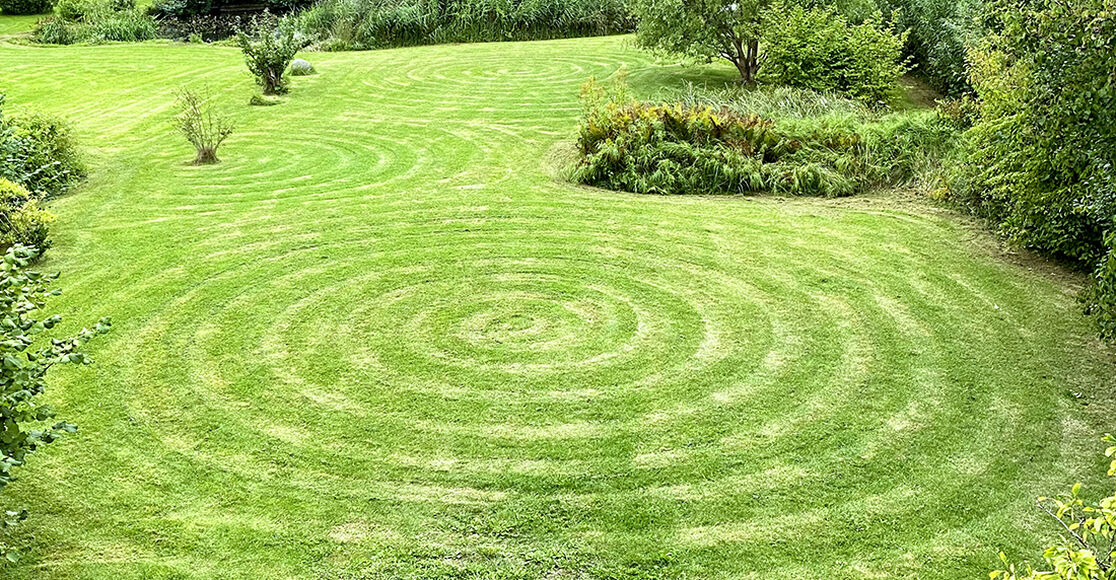Mowing the lawn is one of those outdoor tasks that’s supposed to be done every week, if not more often, but the frequency can also make it feel like a chore. Follow these tips to get creative lawn mowing patterns, help break up the routine and add a bit of fun to your mowing.
Preparation Needed Before Each Mow
Before each mow, take a few minutes to ensure your lawn mower is fueled and ready to go to save you time in the long run. Needing to refuel at any point once you’ve started to mow will add time.
Timing
If you have some flexibility in your schedule, then your lawn can really benefit from a well-timed cut. Mowing in the midmorning (between 8 and 10 a.m.) is typically the best time to mow your lawn because the early morning dew and irrigation has had time to dry, resulting in strong, perky blades of grass. Mowing your lawn in the midmorning also gets you ahead of the beating sun, which can be tiring for you and your grass. However, mowing too early on wet grass can leave ruts, cause grass to clump and settle, and damage your lawn’s roots.
Another good time of the day to mow is late afternoon (between 4 and 6 p.m.) Cooling temperatures during this time of day can reduce stress on you and your grass. Mowing later in the day is not recommended; a freshly cut lawn may be more susceptible to fungus and turf disease related to increasing dew levels during the evening hours.
Mowing Patterns
Depending on the size and shape of your lawn, you’ll want to mow in either rows or circles for the fastest way to mow your lawn. Mowing in rows is usually the quickest, most efficient way to cut your lawn, depending on your lawn orientation. If your lawn is wider than it is long, then you should mow in horizontal rows; mowing the longest rows in your lawn reduces your total number of turns, which allows you to work more quickly overall.
As nice as it is to finish mowing as quickly as possible, it’s also beneficial to your lawn to alternate your mowing pattern. If you constantly mow in the same direction, then grass begins to bend and soil compacts. This situation can lead to reduced airflow, which inhibits growth and can kill grass. Varying the mowing pattern every two to three weeks can help alternate the direction of the grass and maintain healthy growth.
Lawn Features to Consider
If your lawn has features that will be an obstacle to mowing in a uniform pattern, then you can usually save time by getting those areas out of the way first. For example, if you have flower beds or ornamental trees in the center of your lawn, then mow around them before moving on to your chosen pattern. Other features that you may want to tackle first include walkways, landscaping rocks, buildings, gardens and statues.
Lawn Mowing Pattern Techniques
How to Stripe a Lawn
This mowing technique bends the grass so the light reflects on your lawn, which creates a lawn stripe pattern. The best results come when you attach a roller to the back of your mower that will press the grass to the ground. These rollers are available at most garden centers or lawn mower equipment retailers.
How to Mow a Crosshatch Pattern
To create crosshatch or crosscut lawn patterns, begin by mowing the perimeter of your lawn. Next, mow back and forth in opposite directions through your entire lawn. When turning at the end of each row, try taking a “Y” turn to reduce turf damage. Go over the perimeter once more at the end to cover up any offsets in the pattern. To turn regular stripes into plaid crosshatch stripes, mow straight lines back and forth in the opposite direction of the entire lawn. Finish the job by going over the perimeter once more.
How to Get a Crisscross Pattern in Your Lawn
If you’re looking to try a new striping technique, then follow the same steps as above, but mow in a diagonal direction to your previous pattern to create a diagonal or crisscross lawn pattern.
How to Mow Circular Patterns into Your Lawn
To reduce stress on your lawn and vary the look even more, try a circular pattern. The idea follows the same principle as working in rows – limiting the number of turns. Mowing in circles might seem tricky if you’re not used to maintaining that pattern. The control of a zero-turn mower like the Mustang™ Z42 Zero-Turn Rider can allow you to easily navigate uneven or oddly shaped areas in your lawn while maintaining your circular pattern. But you can also mow in concentric circles using a walk-behind mower so all the turns are taken gradually and in the same direction.
How to Mow a Double-Spiral Pattern
If you don’t want to end up in the center of the yard, then you can also try the double-spiral pattern: Follow a circular route, but leave alternating rows unmowed. When you reach the center of your yard, mow in an S-shape so you can begin going over the spirals you skipped. You should end up on the opposite corner of your yard from where you started.
Tips for Vibrant Patterns
- Cutting height: The cutting height you choose will affect the striping intensity. Cutting the grass short will normally lessen the stripe because the shorter grass blade will not bend over as far and therefore reflect less light. A longer cut will enhance the striping pattern and can make a noticeable difference.
- Grass type: Certain breeds of grass will also bend easier and provide a better stripe pattern. Warm season grasses that are typically found in the southern regions of the United States are typically more difficult to stripe because they are more rigid and harder to bend.
